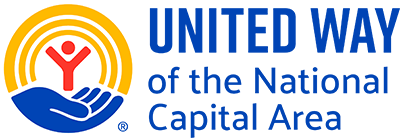
In 2023, many teens and young people will enter adulthood without the essential financial knowledge and skills they need to make informed choices about their money. Promoting financial literacy for teens is critical at this stage of development.
Consider this: Young Americans owe over $1 trillion in debt, and 70% of millennials live paycheck to paycheck. These alarming statistics highlight an urgent need for financial education among young people. Early-adulthood financial decisions can have lifelong consequences. Equipping young people with the tools to manage their money effectively helps them avoid the cycle of debt and economic insecurity that plagues many Americans well into adulthood, giving them the foundation to build a secure financial future.
United Way National Capital Area (United Way NCA) recognizes financial literacy for teens and adults alike as a vital tool for expanding economic opportunity in our community. United Way NCA’s five Financial Empowerment Centers across DC, Maryland, and Virginia provide access to high-quality financial services and guidance—at no cost—to individuals and families of all ages, including teens, to help them build economic stability from an early age. Delve into a personal story of a single mother who utilized our financial empowerment centers to empower herself and her family today. We are specifically focused on the economic opportunity of our region’s ALICE population. ALICE—Asset Limited, Income Constrained, Employed—represents the nearly 500,000 community members in the National Capital Area who are employed and earn more than the Federal Poverty Level, but still struggle to make ends meet.
What is Financial Literacy for Teens?
Financial literacy is the combined knowledge and skills required to make responsible and informed financial decisions that contribute to a sense of financial security and well-being.
Knowledge of financial concepts like saving, investing, spending and borrowing is the foundation of financial literacy. In addition, Understanding credit management, asset building, and how to reduce debt and avoid scams is critical to a healthy financial life. To support financial literacy for teens and young adults, several online tools are available—such as CashCourse.org for college money management, FinAid for understanding student loans, and MoneySkill.org for building essential financial skills. These resources provide interactive, teen-friendly content that promotes financial independence and confidence.
Why Start Early? The Case for Financial Literacy in High School
Financial literacy for teens should begin early—ideally during the high school years—when young people start making real-world financial decisions. At ages 14 to 16, many teens begin to receive allowances, earn money through part-time jobs, or make independent purchasing decisions. These transitional years are a critical time to introduce financial concepts such as saving, budgeting, distinguishing between needs and wants, and setting personal money goals.
According to the SPARK Institute, only 18% of high school students rate their financial literacy as “somewhat high” or “very high,” signaling a widespread gap in knowledge. Meanwhile, a 2023 survey by Empower found that Gen Z places strong value on having emergency funds, budgeting, and avoiding excessive debt by the age of 19—underscoring the desire among teens to make informed financial choices.
Tools like CashCourse.org, MoneySkill.org, and Claim Your Future offer interactive, teen-friendly platforms to explore budgeting, saving for college, and career planning. These resources help reinforce classroom learning and make financial literacy more engaging and applicable.
Parents and educators can further support financial literacy for teens by introducing banking apps and savings tools with supervised access, discussing college costs and scholarship opportunities, and encouraging goal-based saving habits. Encouraging teens to save a percentage of their allowance—such as 10–30%—instills discipline and a deeper understanding of money management.
By equipping students early, we not only prepare them for immediate financial choices but also lay the groundwork for stronger financial literacy for young adults as they transition into college, careers, and independent living.
How Low Financial Literacy Affects Teens and Young Adults
Why is financial literacy for teens and young adults important? Because low financial literacy threatens the well-being of individuals and families, especially in underserved and low-income communities. Without a solid financial foundation, our youth are more susceptible to predatory lending and costly errors in managing debts and expenses that can lead to lifelong financial inequity.
Additionally, low financial literacy can lead to missed wealth-building opportunities and reduced access to higher education and professional development training. When young people lack the financial knowledge they need to make informed decisions, they are more likely to become trapped in cycles of poverty and debt. For example, poor spending and borrowing habits often result in low credit scores, contributing to higher financial insecurity.
Investing in financial literacy helps bridge the opportunity gap that exists in our underserved communities and empowers youth with the tools they need to break down economic barriers and lead financially secure lives.
Navigating Peer Pressure in Teen Financial Decisions
One often overlooked challenge in developing financial literacy for teens is managing money under peer pressure. Social dynamics can influence teens to spend on non-essential items to keep up with friends. Teaching teens to recognize these pressures and make value-based decisions is key to building confidence and self-control. Parents and educators can support teens by encouraging open discussions about needs versus wants and by modeling thoughtful spending behaviors
Closing the Financial Literacy Gap for Teens and Young Adults
According to a July 2022 FINRA Foundation national financial capability study, a persistent financial literacy gap exists in the U.S. The study found that young people—particularly teens—along with Black/African American, Hispanic/Latino, and low-income households, remain more vulnerable to the consequences of low financial literacy than other Americans. This highlights the urgent need to expand access to financial literacy for teens in underserved communities.
The study also showed that the above groups were more likely to exhibit psychological symptoms of financial stress, and younger people were 38% more likely to miss mortgage payments and 26% more likely to make hardship withdrawals from retirement accounts.
These findings highlight the importance of investing in financial education and access to services to help individuals and families build assets and gain economic opportunity. This is especially true for younger people across all demographics.
For Teens and Young Adults: Financial Literacy as the First Step Toward Capability
Financial education—especially financial literacy for teens—is fundamental to improving financial health and well-being for our communities, but developing financial capability is the ultimate goal. Financial capability is what happens when financial literacy knowledge is practiced and applied until it becomes second nature and drives behavior that consistently leads to positive economic outcomes.
It gives individuals the confidence to make informed financial decisions, take advantage of opportunities and build financial security for themselves and their families.
Conclusion
United Way NCA seeks to improve the lives of underserved individuals in our community by increasing economic opportunity for individuals and families across our region.
Our Financial Empowerment Centers teach fundamentals of budgeting, saving, investing, borrowing responsibly and other personal finance topics useful in everyday life and long-term financial planning.
Empowered with the knowledge and skills required to make responsible financial decisions, individuals will build the financial stability necessary for a successful future.
United Way NCA Financial Empowerment Centers provide financial services and expert guidance at no cost in a welcoming, supportive and inclusive environment. Our goal is to be a trusted resource for individuals and families in the communities we serve. For support around credit building, debt management, saving, starting a business, homebuying or completing your taxes, contact a United Way NCA Financial Empowerment Center near you. When none are ignored, all will thrive.
Frequently Asked Questions About Financial Literacy for Teens
What is the 50/30/20 rule for financial literacy?
The 50/30/20 rule is a simple budgeting strategy that recommends dividing income into three categories: 50% for needs, 30% for wants, and 20% for savings. It’s especially helpful when teaching financial literacy for teens, as it introduces a structured approach to managing money early on.
What are the four pillars of financial literacy?
The four key pillars are budgeting, saving, investing, and managing debt. These core areas provide the foundation for strong financial literacy for young adults and help guide better financial decisions throughout life.
What are the 7 key components of financial literacy?
The 7 components include earning, saving, investing, spending, borrowing, protecting, and budgeting. Each element plays a critical role in shaping financially responsible behavior, especially when introduced during the teen years.
What are the big 3 financial literacy questions?
The “big 3” questions test fundamental understanding of interest rates, inflation, and risk diversification. Helping teens and young adults answer these confidently is a strong indicator of growing financial literacy skills.



